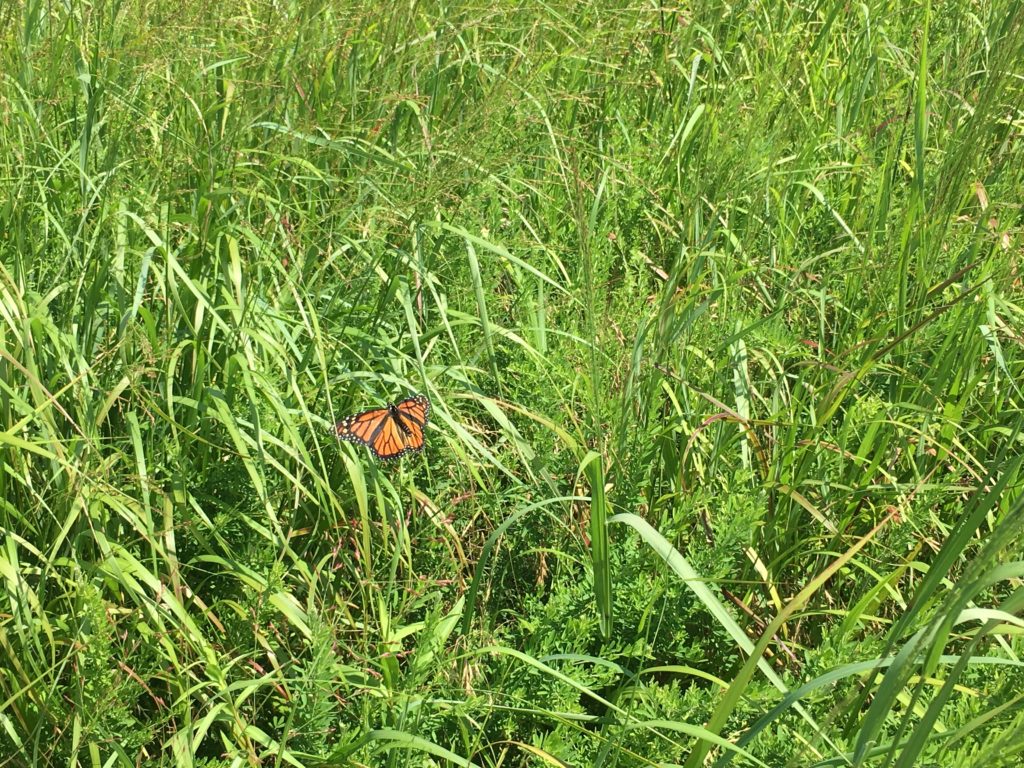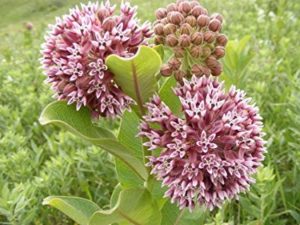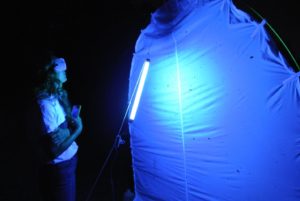Pollinators at Freshkills Park

A monarch on East Mound at Freshkills Park, July 2019
Bees, butterflies, hummingbirds, and bats are just a few examples of the animals that we call pollinators and that we rely on for approximately one third of our food supply and 90% of our world’s flowering plants. When visiting plants for food or shelter, pollinators attract pollen – often in fascinating ways – to themselves and later deposit it on the tops of flowers of the same species, thereby allowing for the creation of new seeds and reproduction.
If you keep up on environmental news, you have most likely heard something about how pollinators are in decline and that we humans bear much of the blame. Study after study sheds light on the alarming decreases in pollinator populations in recent decades. Take the Xerces Society’s 2018 report on the Western Monarch Butterfly, for example, that showed an 86% population downturn last year due to habitat loss, pesticides, and the impacts of climate change like prolonged drought. No more fortunate are North American bat species, many of which have seen over 90% declines in recent years due to an introduced fungus commonly known as “white-nose syndrome”. Lastly, you may have heard about losses in North American bee populations in recent years, often caused by similar factors: pesticides, habitat loss, introduced diseases, and climate change impacts.
 Right here at Freshkills Park, we are doing our part to support pollinators in a number of ways. Recently, Field R/D artist Mary Mattingly planted a pollinator garden outside of the Freshkills Park Studio + Gallery Space as part of her project entitled Four Spheres. The garden currently features blackberry, highbush blueberry, and winterberry and is both a natural artwork and beneficial pollinator habitat. It may eventually be a part of the greater vision for the Freshkills Park design.
Right here at Freshkills Park, we are doing our part to support pollinators in a number of ways. Recently, Field R/D artist Mary Mattingly planted a pollinator garden outside of the Freshkills Park Studio + Gallery Space as part of her project entitled Four Spheres. The garden currently features blackberry, highbush blueberry, and winterberry and is both a natural artwork and beneficial pollinator habitat. It may eventually be a part of the greater vision for the Freshkills Park design.
 In addition to the engineered pollinator habitat at the Studio + Gallery Space, there are a number of pollinator-friendly plants growing wild within the confines of Freshkills Park. In certain areas of the park, for example, Black-eyed Susans abound, providing a food source for not only pollinating insects but also birds and mammals. Elsewhere in the park, Common Milkweed (pictured here), the host plant for the Monarch Butterfly, is notably present. Other plants, such as Fleabane and Tickseed Sunflower, provide nectar for a variety of bees, wasps, and flies.
In addition to the engineered pollinator habitat at the Studio + Gallery Space, there are a number of pollinator-friendly plants growing wild within the confines of Freshkills Park. In certain areas of the park, for example, Black-eyed Susans abound, providing a food source for not only pollinating insects but also birds and mammals. Elsewhere in the park, Common Milkweed (pictured here), the host plant for the Monarch Butterfly, is notably present. Other plants, such as Fleabane and Tickseed Sunflower, provide nectar for a variety of bees, wasps, and flies.
 On the arts and education front, the Freshkills Park team is also working to increase awareness of the critical importance of insect pollinators through a project called “Moth Painting”. Overseen by our Manager for Programs, Arts, and Grants, Mariel Villere, and executed by one of our partner artists Ash Fertlito, “Moth Painting” will represent the rich diversity of moths and other nocturnal insects present in our ecosystem. By placing a large sheet on a plastic framework and then shining UV light on the material, the artist attracts insects to her work and documents them. When the UV light is removed and the insects are gently dispersed, the artist will create a cyanotype depicting the outlines of the insects that visited the display. When the project is complete, it will be a luminous work used for educational and aesthetic purposes.
On the arts and education front, the Freshkills Park team is also working to increase awareness of the critical importance of insect pollinators through a project called “Moth Painting”. Overseen by our Manager for Programs, Arts, and Grants, Mariel Villere, and executed by one of our partner artists Ash Fertlito, “Moth Painting” will represent the rich diversity of moths and other nocturnal insects present in our ecosystem. By placing a large sheet on a plastic framework and then shining UV light on the material, the artist attracts insects to her work and documents them. When the UV light is removed and the insects are gently dispersed, the artist will create a cyanotype depicting the outlines of the insects that visited the display. When the project is complete, it will be a luminous work used for educational and aesthetic purposes.
There are a number of things you can do at home to help pollinators. Often it takes as little as a garden pot or window box, some soil and seeds, and a little bit of diligence to help our bees, butterflies, beetles, hummingbirds, and other pollinators thrive. If you have a balcony or patio at your place of living, here are some helpful tips for planting in urban areas. For more information about what to plant, be sure to visit the Lady Bird Johnson Wildflower Center’s list of pollinator plants native to the mid-Atlantic or Monarch Watch’s list of Northeastern US natives. Regardless of what and where you choose to plant, keep in mind that variety in both color and bloom-time is important, as it will encourage a greater range of species to come for a visit. Pollinators need our help now and often simple actions such as these can go a long way in the effort toward a sustainable future!




